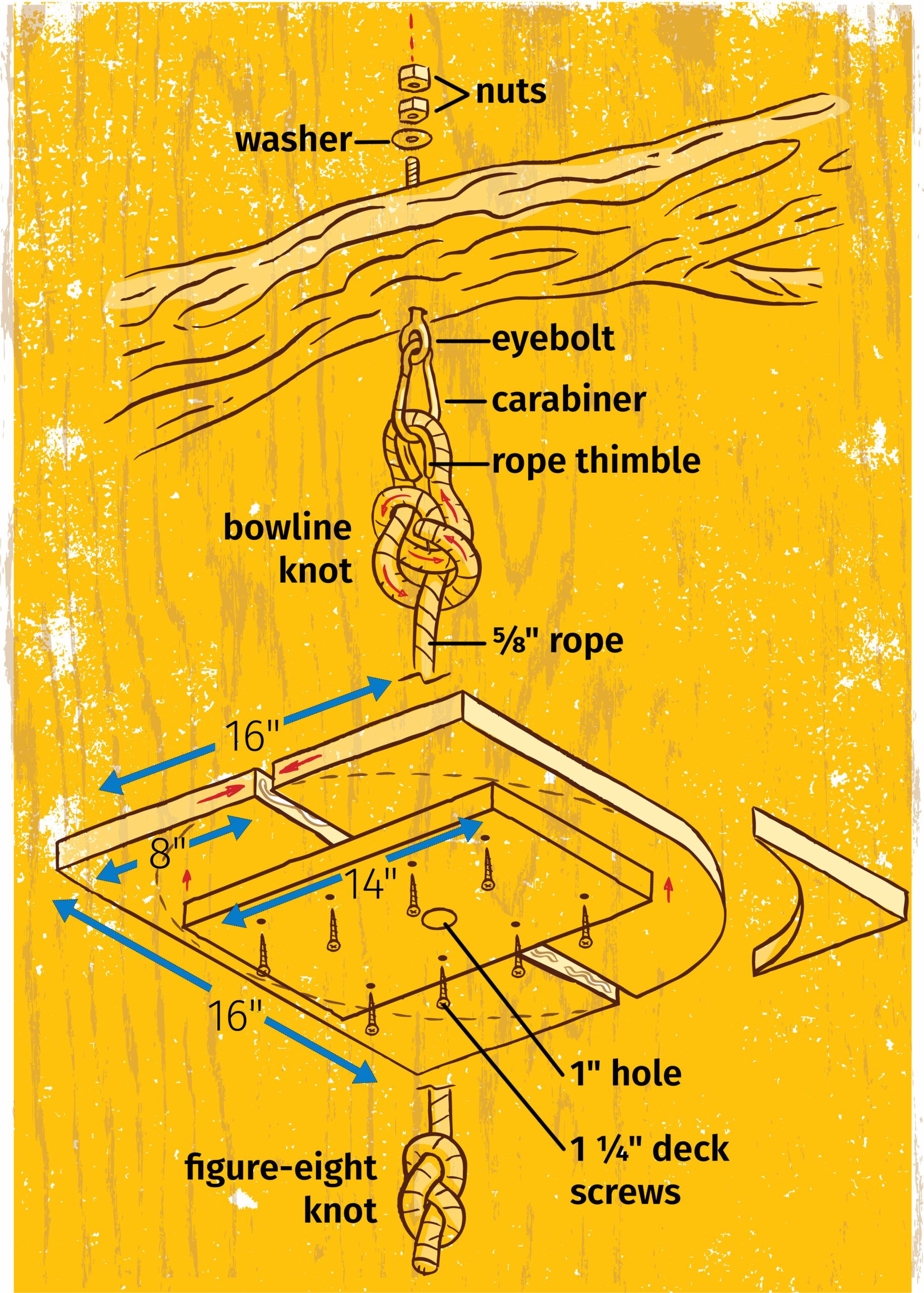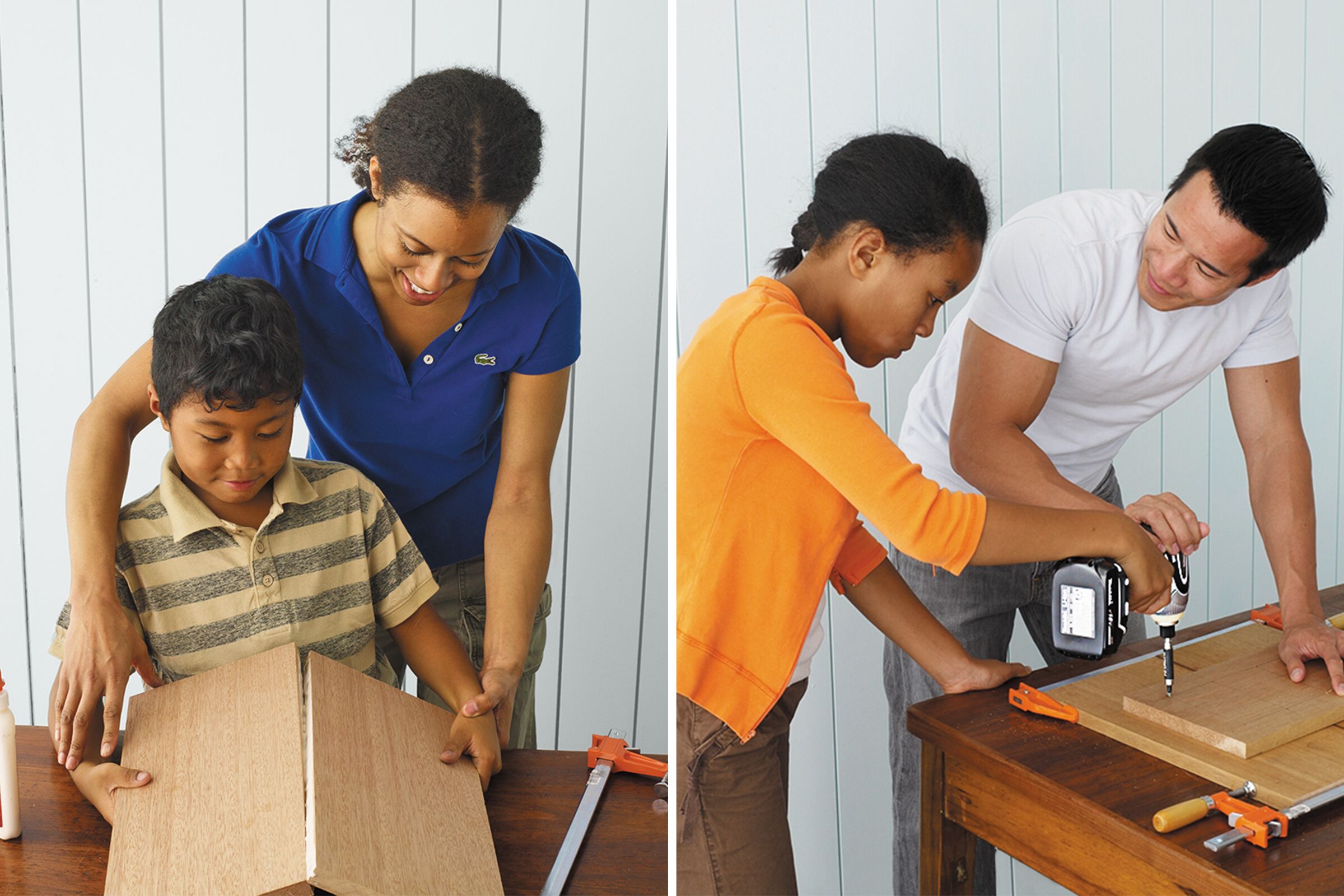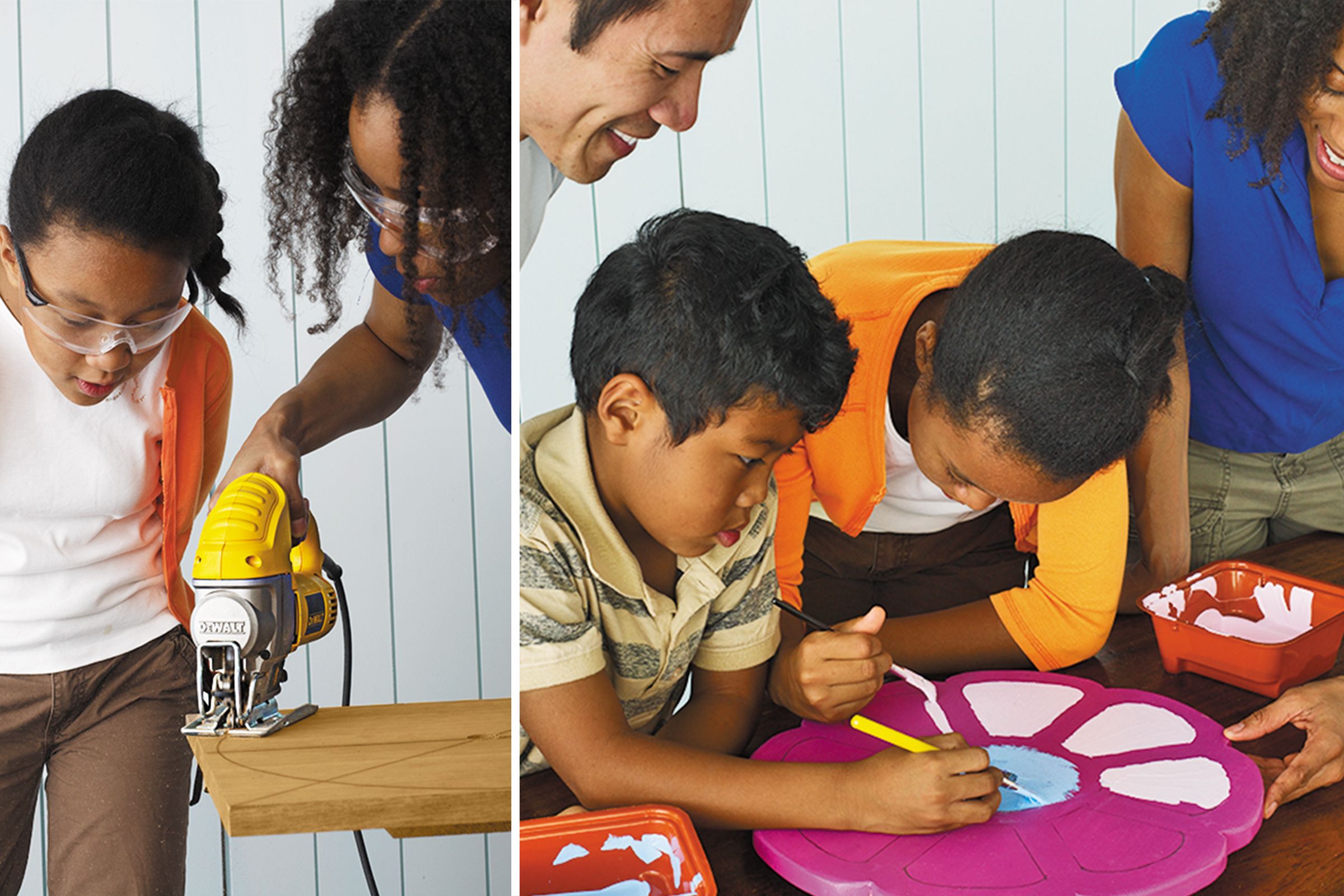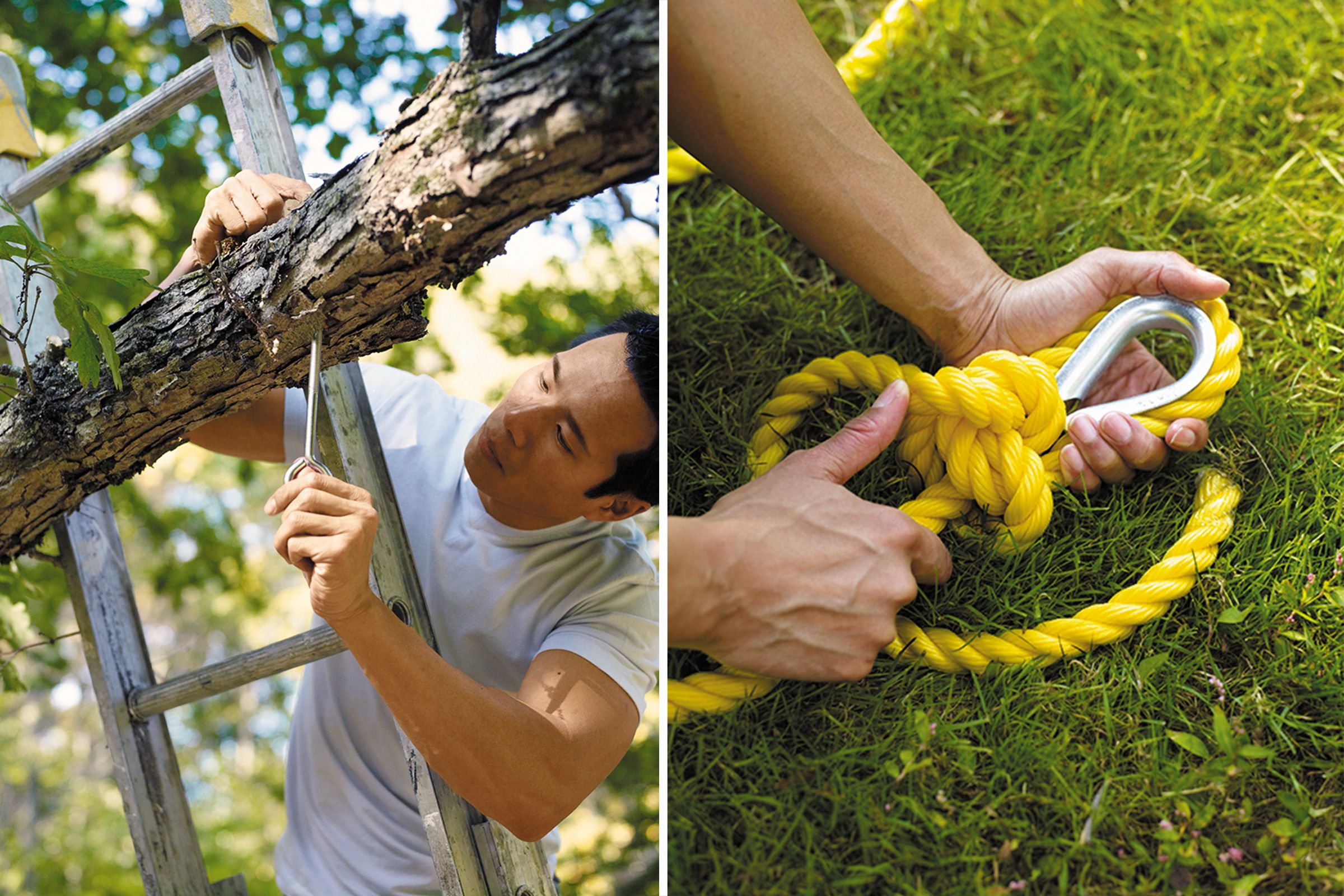Project details
Skill
Cost
Estimated Time
Looking to build a play area for your kids but don’t have the outdoor space? You don’t need a playground set to enjoy your backyard. Instead, build a disc swing: all you need is a seat, a rope, and a sturdy tree.
Making this swing requires a few tools, and all the hardware needed to hang it can be found through the provided links or at your local home center. In the video above, This Old House contractor Roger Cook demonstrates how to construct and install a tree swing, offering valuable tips for a safe and sturdy result.
Choosing the Right Tree and Location

Before you begin building your swing, you must select an appropriate tree and location.
Selecting a Suitable Tree
Consider the following factors:
- Tree health: Select a strong, healthy tree with no signs of disease or decay.
- Branch thickness: Choose a branch that’s at least 8 inches thick. It needs to support the weight of the swing and its users.
- Branch angle: Look for a branch that grows at a 30 to 45-degree angle from the trunk.
- Branch length: Confirm the branch extends far enough from the trunk to allow free swinging.
Assessing the Surrounding Area
Once you’ve identified a potential tree, evaluate the surrounding area:
- Clear space: Make sure there’s enough room for the swing to move freely without hitting obstacles.
- Ground surface: Check that the ground beneath the swing is level and free of rocks or other hazards.
- Visibility: Choose a location where the swing is easily visible from the house for supervision.
Materials Required
Here are the materials you’ll need for your build:
- 1-inch-by-8-inch hardwood board (at least 4 feet long)
- 3/8-inch thick rope (approximately 20 feet)
- 1/2-inch eye bolt (6 inches long)
- 1/2-inch washers and nuts
- 1 1/4-inch wood screws
- Carabiner
- Exterior latex paint
- Rope thimble
- Wood glue
Tools Required
You’ll also need the following tools:
- Clamps
- Combination square
- Drill/driver with various bits
- Jigsaw
- Paintbrushes
- Random orbit sander
- Safety glasses
- Spade bit
- Tape measure
- Wrench
Steps for Building a Tree Swing
Follow these steps to build your tree swing.
Step 1: Layout and Cut the Parts
- Using a tape measure and a combination square, measure out the three pieces of the swing on the 1-inch-by-8-inch board: two 14 1/2-inch-long sections for the seat and one 12-inch-long support brace that goes underneath.
- Clamp the wood tightly to a worktable. Using a jigsaw, cut the three pieces from the board.
- To parents: A jigsaw can send dust and splinters flying. Be sure you and your children wear safety glasses. The helper should be sure to catch the wood, not lift it, so that the saw blade is not pinched.

Step 2: Glue the Seat Together
- Run a thin bead of wood glue on the long edge of one 14 1/2-inch wood piece.
- Fit it side by side to the other 14 1/2-inch piece, then clamp them together tightly with bar clamps. This is your seat.
- Allow the glue to dry.
Step 3: Attach the Seat Support
- Glue the 12-inch support board across the seam in the middle of the seat bottom, with the long edges of the board perpendicular to the seam. Clamp the pieces together.
- Drill eight pilot holes through the support with a 3/16-inch bit. Each long side of the support should have four evenly spaced holes, two on each side of the seam.
- Attach it to the seat with 1 1/4-inch screws.
Step 4: Drill a Hole for the Rope
- Flip the seat so that it’s face up. Draw two diagonal lines from corner to corner, making an X. As if cutting a pie, draw another X over it, making eight equal slices. Put the point of a compass at the center, then draw the largest circle that will fit on the seat.
- Clamp the seat to the worktable. Using a drill/driver fitted with a 1-inch spade bit, drill a hole for the rope at the center of the seat.

Step 5: Cut Out the Seat
- Using a jigsaw, cut out the seat shape. Halfway through the cut, you’ll need to unclamp the seat, turn it around, and clamp it again before you finish making the whole circle.
- If you want your seat to look like a flower, make a mark 1/2 inch on either side of each radiating line along the circle’s edge. Then, mark each line 1/2-inch from the edge. Using a jigsaw, cut between these points to shape the curved edges of the petals.
- Using a random-orbit sander, smooth away splinters and round over any sharp edges.
Step 6: Paint the Design
- Using exterior latex paint, brush the background color onto the seat. Coat the entire surface—top, bottom, and edges—to seal the wood. Allow the paint to dry.
- Draw the flower or other pattern in pencil on the background color. Use artist’s brushes to fill in the design with more exterior paint.
Step 7: Drill Through the Tree Limb
- Pick out a tree with a healthy limb that’s parallel to the ground and at least 8 inches thick. Make sure there’s room for the seat to swing freely without hitting the tree trunk.
- Using a long 5/8-inch spade bit, drill a hole vertically through the center of the limb.
- To parents: Be sure the tree limb you choose is alive and healthy so that it won’t break under a child’s weight.

Step 8: Attach the Eyebolt
- Thread an eyebolt through the hole so that the eye faces down.
- Slip on a washer, then two nuts, one after the other. Use a wrench to tighten the two nuts as you hold the loop of the bolt steady with a screwdriver.
Step 9: Hang the Swing With a Rope
- Tie one end of a long rope into a bowline knot around a thimble. Connect the thimble to the eyebolt with a carabiner.
- Slip the dangling end of the rope through the seat’s hole. Tie a figure-eight knot under the seat so it sits at a comfortable height for kids.
Tree Swing Construction Safety
Safety should always be your priority, especially when building something for kids. Remember these important factors throughout the building and installation process.
Choosing Quality Materials
- Use sturdy, rot-resistant hardwood for the seat.
- Select a high-quality, weather-resistant rope rated for outdoor use.
- Opt for galvanized or stainless steel hardware to prevent rust.
Regular Maintenance
- Inspect the swing regularly for signs of wear or damage.
- Check the rope for fraying or weakening, especially near the knots.
- Examine the tree branch and hardware for any changes or loosening.
Safe Usage
- Teach children how to use the swing safely.
- Supervise young children during swing use.
- Establish clear rules about maximum weight limits and appropriate behavior.
Customizing Your Tree Swing
One of the joys of building your tree swing is the ability to personalize it. Here are some ideas to make your swing unique and even more enjoyable.
Creative Seat Designs
- Paint the seat to resemble a favorite character or animal.
- Add cushioning for extra comfort.
- Attach nonslip material to the top of the seat for better grip.
Rope Variations
- Use colorful rope to match your outdoor decor.
- Try braided rope for a more traditional look.
- Consider using a chain for part of the hanging system for added durability.
Additional Features
- Hang wind chimes or bells from the bottom of the seat.
- Attach reflective tape or glow-in-the-dark paint for nighttime visibility.
- Create a canopy or shade cover for sun protection.
Adding More Swing Accessories
Beyond just the seat and rope, there are several ways to enhance your tree swing:
- Footrests: Attach small wooden blocks or boards to the bottom of the rope so that children can rest their feet.
- Backrests: Create a simple backrest by attaching an additional piece of wood to the seat.
- Handles: Secure handles to the sides of the seat for added stability and safety.
Themed Swings
Consider creating themed swings to match your garden or backyard aesthetic. Try the following ideas:
- Pirate ship: Add nautical colors, a pirate flag, and ship wheel designs.
- Fairy garden: Use pastel colors, flower decorations, and fairy lights.
- Space explorer: Paint the seat with planets and stars, and add glow-in-the-dark elements.
